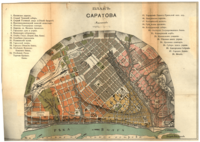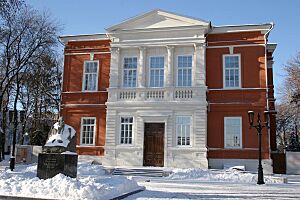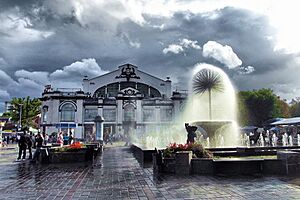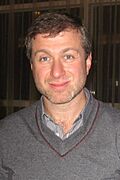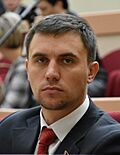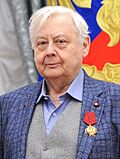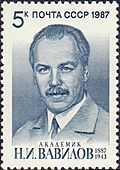Saratov facts for kids
Quick facts for kids Saratov (English)Саратов (Russian) |
|
|---|---|
| - City - | |
 Top upper left: Pokrovskaya Church (Church of the Intercession of the Most Holy Theotokos) in Saratov, Top lower left: Saratov Administration Office, Top right: Saratov Conservatory, Middle left: Saratov Orthodox Theological Seminary, Middle right: Schmidt Mill, Bottom: A twilight view of Saratov Engels Bridge and the Volga |
|
|
|
|
| Administrative status (as of 2014) | |
| Country | Russia |
| Federal subject | Saratov Oblast |
| Administratively subordinated to | city of oblast significance of Saratov |
| Municipal status (as of December 2004) | |
| Urban okrug | Saratov Urban Okrug |
| Head | Mikhail Isayev |
| Representative body | City Duma |
| Statistics | |
| Population (2010 Census, preliminary) |
837,900 inhabitants |
| - Rank in 2010 | 16th |
| Population (January 2015 est.) | 842,097 inhabitants |
| Time zone | MSK (UTC+04:00) |
| Founded | ca. 1590 |
| City status since | 1708 |
| Postal code(s) | 410000–410005, 410007–410010, 410012, 410015, 410017–410019, 410022, 410023, 410025, 410028–410031, 410033–410042, 410047–410056, 410059, 410060, 410062–410065, 410068, 410069, 410071, 410074, 410076, 410078, 410080, 410082, 410086, 410700, 410880, 410890, 410899, 410960–410965, 410999 |
| Dialing code(s) | +7 8452 |
| Official website: http://www.saratovmer.ru | |
Saratov (UK: /səˈrɑːtɒf/ sə-RAH-tof, US: /-təf/ --təf; Russian: Саратов, pronounced [sɐˈratəf]) is a large city in Russia. It is the main city of Saratov Oblast and an important port on the Volga River.
As of 2021, Saratov had a population of over 900,000 people. This makes it one of the largest cities in Russia. It is about 389 kilometers north of Volgograd and 858 kilometers southeast of Moscow.
The city is located near where an old city called Ukek once stood. Saratov was likely built as a fortress to protect Russia's border. It grew into a busy shipping port. Many Volga Germans lived here before World War II.
Saratov is also a center for culture and education. It has a famous drama theater, a music conservatory, and several universities.
Contents
What's in a Name?
The name Saratov might come from Sary Tau. This means "Yellow Mountain" in the Tatar language. Another idea is that it comes from Sar Atau, meaning "Boggy Island".
A Look Back in Time
![]() Tsardom of Russia (1590–1721)
Tsardom of Russia (1590–1721)
![]() Russian Empire (1721–1917)
Russian Empire (1721–1917)
![]() Russian Republic (1917–1918)
Russian Republic (1917–1918)
![]() Russian Soviet Federative Socialist Republic (1918–1922)
Russian Soviet Federative Socialist Republic (1918–1922)
![]() Union of Soviet Socialist Republics (1918–1991)
Union of Soviet Socialist Republics (1918–1991)
![]() Russian Federation (1991–present)
Russian Federation (1991–present)
An ancient city called Ukek was near Saratov from the 1200s until 1395. Modern Saratov was likely founded around 1590. This was during the time of Tsar Feodor I of Russia. He built towns along the Volga River to protect his country's borders. Saratov officially became a town in 1708.
By the 1800s, Saratov became a very important shipping port. A railway reached the city in 1870. This railway later crossed the Volga River in 1896. For many years, a special train-ferry helped trains cross the river. A railway bridge was finally built in 1935.
During World War II, Saratov was important for supplying troops. It was a key stop on a military railway line. The city was bombed by German planes in 1942-1943.
Until 1991, Saratov was a "closed city". This meant foreigners were not allowed to visit. This was because the city had important military aircraft factories.
The German Community
Saratov has a special connection to the Volga Germans. These were German people who moved to the Volga region. They were promised they could keep their German language and culture. They had their own schools, churches, and newspapers.
Over time, conditions changed. Some Volga Germans began to move to other countries. These included the United States, Canada, Brazil, and Argentina. In 1941, many ethnic Germans were moved from the area.
Today, there are few reminders of the Volga Germans. A Catholic church they built was changed into a cinema. The main street, once called "German Street," is now named Kirov Prospect.
City Government
Saratov is the main administrative center for the Saratov Oblast region. It is also the administrative center for Saratovsky District. However, it is not actually part of that district itself. Instead, Saratov is a special administrative unit. It has the same status as a district.
For local government, Saratov is known as the Saratov Urban Okrug. This means it has its own city government.
Geography and Weather
Climate
Saratov has a continental climate. This means it has warm summers and cold winters. The weather is often dry and sunny.
July is the warmest month, with average temperatures around 23°C (73°F). February is the coldest, with temperatures around -8°C (18°F). Summers can be very hot, sometimes reaching over 30°C (86°F). In 2010, it even reached 40.9°C (105.6°F).
Winters bring a lot of snow and ice. Temperatures can go well above freezing or drop below -25°C (-13°F).
| Climate data for Saratov (1991-2020, extremes 1836-present) | |||||||||||||
|---|---|---|---|---|---|---|---|---|---|---|---|---|---|
| Month | Jan | Feb | Mar | Apr | May | Jun | Jul | Aug | Sep | Oct | Nov | Dec | Year |
| Record high °C (°F) | 8.1 (46.6) |
8.4 (47.1) |
18.8 (65.8) |
31.1 (88.0) |
34.1 (93.4) |
39.2 (102.6) |
40.8 (105.4) |
40.7 (105.3) |
36.7 (98.1) |
25.5 (77.9) |
17.1 (62.8) |
11.7 (53.1) |
40.8 (105.4) |
| Mean daily maximum °C (°F) | −4.7 (23.5) |
−4.3 (24.3) |
1.8 (35.2) |
13.8 (56.8) |
22.1 (71.8) |
26.4 (79.5) |
28.6 (83.5) |
27.4 (81.3) |
20.3 (68.5) |
11.6 (52.9) |
2.3 (36.1) |
−3.3 (26.1) |
11.8 (53.3) |
| Daily mean °C (°F) | −7.6 (18.3) |
−7.7 (18.1) |
−1.8 (28.8) |
8.5 (47.3) |
16.3 (61.3) |
20.6 (69.1) |
22.9 (73.2) |
21.3 (70.3) |
14.8 (58.6) |
7.5 (45.5) |
−0.4 (31.3) |
−5.9 (21.4) |
7.4 (45.3) |
| Mean daily minimum °C (°F) | −10.2 (13.6) |
−10.5 (13.1) |
−4.8 (23.4) |
4.3 (39.7) |
11.2 (52.2) |
15.6 (60.1) |
17.7 (63.9) |
16.1 (61.0) |
10.4 (50.7) |
4.3 (39.7) |
−2.6 (27.3) |
−8.3 (17.1) |
3.6 (38.5) |
| Record low °C (°F) | −37.3 (−35.1) |
−34.8 (−30.6) |
−26.8 (−16.2) |
−17.8 (0.0) |
−3.8 (25.2) |
2.1 (35.8) |
6.4 (43.5) |
4.3 (39.7) |
−2.9 (26.8) |
−12.6 (9.3) |
−23.8 (−10.8) |
−33.4 (−28.1) |
−37.3 (−35.1) |
| Average precipitation mm (inches) | 43 (1.7) |
36 (1.4) |
33 (1.3) |
31 (1.2) |
36 (1.4) |
48 (1.9) |
44 (1.7) |
27 (1.1) |
50 (2.0) |
38 (1.5) |
39 (1.5) |
41 (1.6) |
466 (18.3) |
| Average rainy days | 6 | 5 | 7 | 12 | 14 | 15 | 14 | 12 | 13 | 14 | 12 | 8 | 132 |
| Average snowy days | 19 | 15 | 10 | 1 | 0 | 0 | 0 | 0 | 0 | 1 | 9 | 16 | 71 |
| Average relative humidity (%) | 84 | 81 | 78 | 64 | 55 | 59 | 59 | 59 | 64 | 74 | 84 | 84 | 70 |
| Mean monthly sunshine hours | 57 | 81 | 141 | 219 | 278 | 310 | 320 | 273 | 152 | 115 | 60 | 50 | 2,056 |
| Source 1: Pogoda.ru.net | |||||||||||||
| Source 2: worldweather.wmo.int | |||||||||||||
Economy and Transport
Saratov Oblast is a very industrial area. This is because it has many natural resources. The region is also a big center for culture and science in Russia. Saratov has many research institutes and universities. These include the Saratov State University and the Saratov State Technical University.
Getting Around
Saratov has the Saratov Gagarin Airport. It opened in 2019 and has flights to many places. There are also other smaller airfields nearby. The Engels-2 (air base) is a major base for Russian bombers.
Highways connect Saratov to other big cities like Volgograd and Samara. Railways are also very important for transport. The Privolzhskaya Railway has its main office in Saratov. The Volga River itself is a key waterway for boats.
Inside the city, people use buses and trolleybuses to get around. Saratov also has a tram network that started in 1908. A new trolleybus route opened in 2021. It connects Saratov to the nearby city of Engels across the Volga River.
People of Saratov
| Historical population | ||
|---|---|---|
| Year | Pop. | ±% |
| 1897 | 137,000 | — |
| 1926 | 212,395 | +55.0% |
| 1939 | 372,002 | +75.1% |
| 1959 | 584,092 | +57.0% |
| 1970 | 757,330 | +29.7% |
| 1979 | 855,702 | +13.0% |
| 1989 | 904,643 | +5.7% |
| 2002 | 873,055 | −3.5% |
| 2010 | 837,900 | −4.0% |
| 2021 | 901,361 | +7.6% |
| Source: Census data | ||
Saratov has a population of over 900,000 people. Most of the people living in Saratov are Russians. Other groups include Tatars, Kazakhs, Armenians, Azerbaijanis, and Ukrainians.
Here are the main ethnic groups from the 2021 Census:
|
Education in Saratov
Saratov is home to many colleges and universities. Some of the well-known ones are:
- Saratov State University (founded in 1909)
- Saratov State Technical University
- Saratov State Medical University
- Saratov State Academy of Law
- Saratov State Agrarian University
In 2014, a newly updated campus for the Saratov Regional College of Art was opened.
Culture and Arts
One of Saratov's most famous buildings is the Saratov Conservatory. It has a beautiful old-style design. When it opened in 1912, it was only the third music conservatory in Russia. At that time, Saratov was a very large city. The building was first a music school. It was rebuilt before the conservatory opened. About 1,000 students were ready to study there when it first opened.
The Saratov Drama Theater is one of Russia's oldest theaters, started in 1802. It is considered one of Russia's National Theaters. It is now named after Ivan Slonov, a famous actor and teacher from the city.
Saratov also has several art museums. The Radishchev Art Museum is very famous. It has over 20,000 art pieces. These include old Russian icons and works by famous artists like Camille Corot and Auguste Rodin. You can also see paintings by great Russian artists such as Ilya Repin and Ivan Shishkin.
Sports Teams
Saratov has several sports clubs that play in different leagues:
| Club | Sport | Founded | Current League | League Rank |
Stadium |
|---|---|---|---|---|---|
| Kristall Saratov | Ice Hockey | 1955 | Higher Hockey League | 2nd | Kristall Sports Palace |
| Sokol Saratov | Football | 1930 | Russian Football National League | 2nd | Lokomotiv Stadium |
| Avtodor Saratov | Basketball | 1960 | VTB United League | 1st | Kristall Sports Palace |
| Universal Saratov | Bandy | 1953 | Bandy Supreme League | 2nd | Dynamo Stadium |
| Proton Saratov | Volleyball | 1988 | Volleyball Superleague | 1st |
Sister Cities
Saratov is connected with other cities around the world. These are called "sister cities":
Famous People from Saratov
- Roman Abramovich (born 1966), a well-known businessman
- Boris Andreyev, actor
- Oleg Antonov, aircraft designer
- Boris Babochkin, actor and director
- Rachel Bluwstein, poet
- Alexey Bogolyubov, painter
- Nikolai Bondarenko, politician
- Viktor Borisov-Musatov, painter
- Nikolay Chernyshevsky, philosopher
- Gavrila Derzhavin, poet
- Irina Dryagina, World War II pilot and scientist
- Katia Elizarova, model
- Konstantin Fedin, writer
- Nikolai Grandkovsky, painter
- Joseph Hakobyan, engineer
- Lev Igorev, painter
- Anastasia Karpova, pop singer
- Lev Kassil, writer
- Kombinaciya, a female pop band
- Pavel Kuznetsov (1878–1968), painter and graphic artist
- Eduard Limonov, writer and politician
- Konstantin Lokhanov (born 1998), a junior world champion in fencing
- Konstantin Paustovsky, writer
- Kuzma Petrov-Vodkin, painter
- Lev Pitaevskii, theoretical physicist
- Natalia Pogonina, chess Grandmaster
- Jean-Victor Poncelet, French engineer and mathematician
- Alexander Radishchev, writer
- Lidiya Ruslanova, Russian folk singer
- Sweeney Schriner, Russian-born Canadian ice hockey player
- Nikolay Semyonov, Nobel Prize-winning chemist
- Ellen Sheidlin, photoblogger and painter
- Fyodor Shekhtel, architect
- Leonid Sobinov, opera singer
- Pyotr Stolypin, statesman
- Vladimir Stoupel, Russian-born French pianist and conductor
- Elvira T, singer and songwriter
- Oleg Tabakov, actor
- Evgeny Tomashevsky, chess Grandmaster
- Valeriya, pop singer
- Nikolai Vavilov, biologist and geneticist
- Mikhail Vrubel, painter
- Oleg Yankovsky, actor
- Zedd, music producer and DJ
- Nikolay Zinin, chemist
See also
 In Spanish: Sarátov para niños
In Spanish: Sarátov para niños



